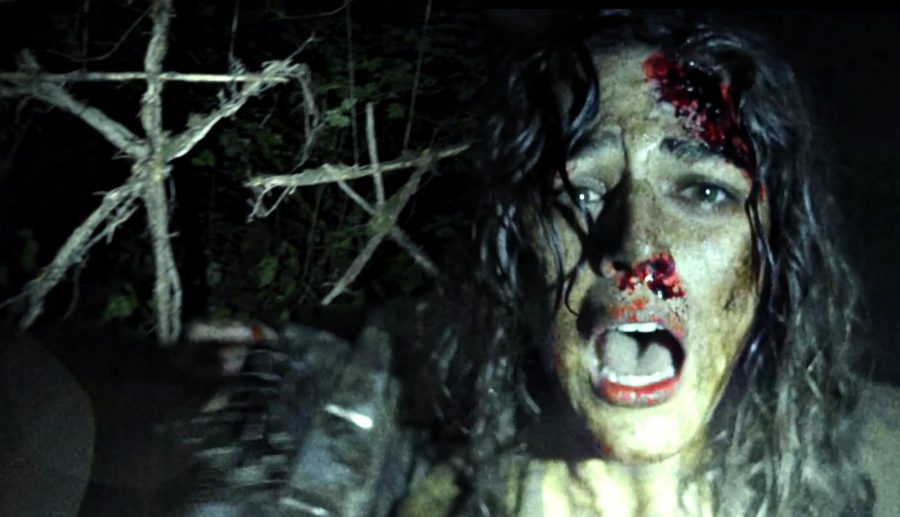Spectra Film Review: BLAIR WITCH
Back in 1999, a small horror film took the world by storm. That movie was called “The Blair Witch Project” it was produced on a minuscule budget of just around $60,000, and it grossed over $200 million, thus cementing itself in the history books as the most profitable film of all time. When you look at the landscape – (three backpackers hiking in the woods, trying to hunt down an urban folklore, while videotaping every moment to only get lost in an never-ending loop that results in some bad news) – it’s really not that complex. In fact, it’s rather simple in the execution of how it wants to scare you. That was also partly due to a robust marketing campaign that sold the original “Blair Witch” as a real life documentary. So people believed that what they were seeing was real. The movie itself has stood the test of time, and has been the grandfather to what we now call the “found-footage” genre.
What was originally entitled “The Woods” and then, to many, at Comic-Con this past summer was screened as “Blair Witch” was a secret sequel that nobody, literally, nobody knew about. In a weird way, it took the convention by storm, mainly because nobody saw it coming. So kudos to Lionsgate for somehow managing to stir the pot, and garner some much needed interest for what is, otherwise, a convoluted puzzle that never fills in the gaps.
Selling itself as a sequel (and very far removed from “Blair Witch 2: Book Of Shadows”) “Blair Witch” takes the same style, techniques, and narrative to fuel the progress into this latest chapter. As we chronicle the livelihood of James (James Allen McCune), Lisa (Callie Hernandez), Ashley (Corbin Reid), and Peter (Brandon Scott) as they set out to make a film depicting the events which occurred in the black hills forest circa 17 years ago when James sister, Heather, disappeared. As the film opens, our squad has come across a package containing footage which could, somehow, trace the last known whereabouts of Heather, and give James the closure he desperately needs to move on in life.
Of course, the gang straps on their cameras, microphones, and infinite battery life to head out into the woods (because, as horror movies dictate, that’s a terrific idea). What ensues then is your basic, run of the mill, spooks that are more built on static than actually scaring you. Director Adam Wingard (who helmed the brilliant “You’re Next” and “V/H/S” films) builds his structure on the foundation of what was left for him from the original “Blair Witch” which leaves him to produce some mildly thrilling scares as a result. After all, this is the man who delivered one of the best horror films of the last five years, suffice to say, he can elicit a jolt or two (even if they are cheap).
All gimmicks aside, the overall movie still feels lifeless in the narrative. YES, we understand, something is lurking outside in the woods, we hear strange noises, so we try to do something about it. Wingard offers up more background than he can chew, and sometimes the ideas which he presents, like a time-looping paradox within the woods that makes days never end, fail to sustain their intended purposes.
As is normal in circumstances with these films, the actors are all unknowns (except for Valorie Curry (who plays Tailia) a ghost story nut who, along with her boyfriend Lane (Wes Robinson) believe in the urban legend of the Blair Witch and only tag along for the ride (a decision which will later be regretted) for their own inner proposes.
Don’t expect much closure to that folk lore though because “Blair Witch” doesn’t offer much answers for the questions that it puts forth. Hardly ever do you feel an emotional bond between James and his long-lost sister, nor do we get the ending this movie rightfully deserves. With as good a director as Wingard is, I was disappointed in the relentless ending (which goes on for quite some time) that has a monumental build-up, only to fall into a typical troupe of genre ridden cliches. What made the original so fresh was that it made the audience use its imagination, the sounds of crackling sticks, the whistling of the wind, and three college students lost in the woods somehow awoke my deepest fears of being stranded with nowhere to go. My main point here is that “The Blair Witch Project” sustained the term, ‘less was more.’
I suppose the good news is that Wingard has an eye for staging regardless, and even if the property can’t keep up with the style of shooting, everything else seems secondary. Then again, I’m thinking what anyone else is thinking while watching a movie like this: I would never have been in these woods in the first place. C+


